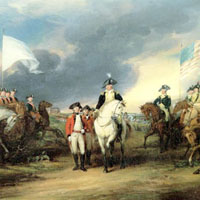Milestones
- 1776-1783: Diplomacy and the American Revolution
- Continental Congress, 1774-1781
- Secret Committee of Correspondence/ Committee for Foreign Affairs, 1775-1777
- The Declaration of Independence, 1776
- The Model Treaty, 1776
- French Alliance, French Assistance, and European Diplomacy during the American Revolution, 1778-1782
- Benjamin Franklin: First American Diplomat, 1776-1785
- Articles of Confederation, 1777-1781
- Treaty of Paris, 1783
Milestones: 1776-1783
1776-1783: Diplomacy and the American Revolution
In the 1770s, the increasingly defiant American colonies began exploring the possibility of independence from the British Government.

General George Washington at Yorktown
As tensions mounted and armed conflict erupted, the colonists, who were economically dependent on Europe, recognized that European nations were unlikely to conclude trade agreements with the Americans unless they declared their independence. The U.S. Continental Congress endorsed Thomas Jefferson's Declaration of Independence on July 4, 1776, and, with it, the conflict with Britain became a full-fledged War of Independence.
Unable to defeat the strong British military on their own, the American colonists required foreign assistance. John Adams approached the French with the “Model Treaty” that protected neutral trade and shipping rights in the event of a war. The French decision to sign this commercial treaty with the American colonists made them an ally in the war against Britain.
In 1778, the French formally established their position as an ally with a treaty of alliance that committed the French to the war on the condition that the Americans did not seek a separate peace with Britain. Following the British surrender at the Battle of Yorktown, however, the Americans negotiated independently despite their agreement with France. Ultimately, the French reacted mildly out of concern for their own position with regard to Britain and Spain. The final treaty granted full independence and recognized the borders of the new United States of America.
